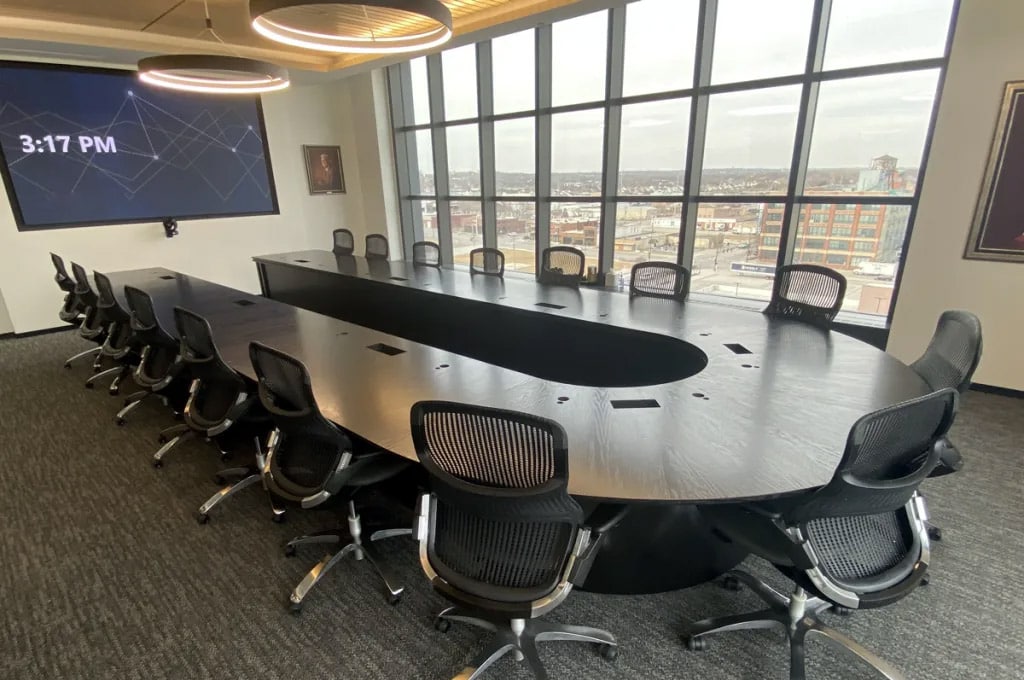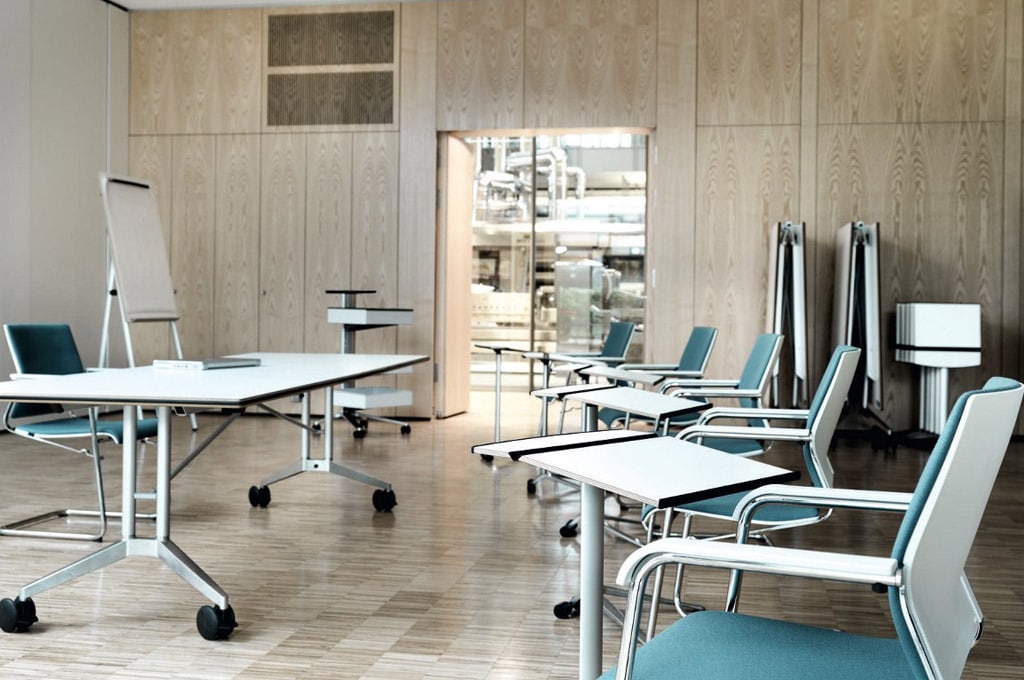In today's fast-paced business environment, meetings have become essential for effective communication, collaboration, and decision-making. A crucial factor that can significantly impact the success of a meeting is the choice of the conference table.The right type of conference table can foster engagement,enhance productivity, and create a comfortable environment for participants.
In this blog, we will delve into the various conference table types, exploring their features, benefits, and ideal applications. By understanding the different office meeting table shapes and configurations available, you can make an informed decision when selecting the best office meeting table for your meeting room table needs.
Different Types of Conference Tables - Why Do They Matter?
At first sight it may seem that the design of tables is largely an aesthetic choice, or one influenced primarily by the number of people that need to be accommodated. However, there is a lot more to be taken into consideration, such as the specific meeting application for the room and whether video conferencing capability is important.
Different Types of Conference Tables
Horseshoe Table: Enhancing Interaction and Presentation
The horseshoe table configuration resembles a semi-circle with an open end, providing a unique seating arrangement for meetings. Horseshoe tables are ideal for presentations, training sessions, and interactive discussions where both presenter and audience involvement are crucial. The curved shape naturally directs the attention towards the presenter, facilitating visual and verbal communication.

Lorem ipsum dolor sit amet
Benefits:
– Better Interaction: This design fosters better face-to-face interaction among participants, creating an intimate and engaging atmosphere
– Easy Access: The open end of the table allows for easy access and encourages presenters to move freely within the space.
– Better Vision: This type of table also encourages participants to actively engage with each other, as everyone has a clear line of sight to one another.
Suitable For: Better for medium audiences and rooms like boardrooms, since it brings focus on the presenter
Classroom Table: Promoting Focus and Learning
The classroom table is a traditional rectangular design with seating arranged on one side. This setup is commonly used in educational settings, boardrooms, and seminars. The classroom table is particularly suitable for formal presentations, workshops, and situations where a structured learning atmosphere is desired. Participants can easily take notes, refer to handouts, and engage in interactive activities while maintaining a clear line of sight to the presenter.

Lorem ipsum dolor sit amet
Benefits:
– More Focus: This table promotes a focused learning environment, with the presenter or facilitator positioned at the head of the table.
– Spacious: Visual aids and presentation materials can be conveniently displayed and referenced.
Suitable For: Best suited for classroom or training rooms where there is an instructor
Wedge-Shaped Table: Facilitating Communication and Collaboration
Wedge-shaped tables feature a narrowing, triangular design that creates a unique seating arrangement. The close proximity of participants enhances communication, encourages the free flow of ideas, and creates a more cohesive and collaborative environment. The wedge-shaped table encourages engagement and teamwork, making it an ideal choice for small to medium-sized groups. It is particularly effective for brainstorming sessions, group discussions, and team-building activities where active participation and idea sharing are essential.

Lorem ipsum dolor sit amet
Benefits:
– Better communication: This configuration promotes direct communication and eye contact among participants, fostering a sense of intimacy and collaboration.
– Easy Interaction: The angled shape of the table facilitates easy interaction and allows participants to engage with each other without physical barriers.
Suitable For: This is ideal for small and medium sized VC rooms as both in-room and virtual participants can see each other better.
Flexible Seating or Retractable Table: Versatility for Dynamic Spaces
In today’s modern workplaces, flexibility is key. Flexible seating arrangements with movable or retractable tables offer versatility, allowing meeting rooms to adapt to different setups and requirements. This table type is ideal for multi-purpose spaces or organisations that frequently host diverse types of meetings. It maximises the utilisation of space and provides the flexibility to adapt to changing meeting dynamics.

Lorem ipsum dolor sit amet
Benefits:
– Retractable tables can be easily rearranged to accommodate various meeting styles, such as boardroom-style, classroom-style, or even an open collaboration space.
– Flexible seating promotes creativity and innovation by providing a dynamic environment that can be tailored to the specific needs of each meeting or activity. It allows for easy reconfiguration, facilitating smooth transitions between different meeting formats.
Suitable For: Ideal for multi-purpose collaboration spaces or divisible meeting rooms
Which Table is Best Suited to Your Meeting Room’s Needs?
Choosing the best table for your meeting room requires careful consideration of various factors. Here are some key points to help you determine the table type that is best suited to your meeting room’s needs:
Room Size
– Small to Medium Rooms: If you have a small to medium-sized space, oval conference tables or round tables can maximise seating capacity while promoting an inclusive and collaborative environment.
– Larger Rooms: For larger rooms, rectangular or horseshoe tables may be more suitable to ensure better visibility and interaction among participants.
Meeting Purpose
– Presentations/Trainings: If you frequently conduct presentations or training sessions, a horseshoe or classroom-type table can provide an optimal setup for the presenter and attendees.
– Sharing Ideas: If you prioritise active participation and idea sharing, wedge-shaped meeting room tables create an intimate setting that encourages communication and collaboration.
Interaction Style
– Open Interaction: If you aim for equal participation and open dialogue, round or oval conference tables facilitate face-to-face interaction and ensure that everyone feels included.
– Closed Interaction: If you prefer a more structured setting where the presenter or facilitator takes the lead, a classroom-type table with seating on one side can establish a clear hierarchy.
Conclusion
Selecting the right office meeting table type is crucial for creating a productive, collaborative, and comfortable environment for meetings. The choice depends on factors such as room size, desired interaction style, and the purpose of the meeting.
Round/O-shaped tables foster inclusion and collaboration, horseshoe tables enhance interaction and presentation, classroom-type tables promote focus and learning, wedge-shaped tables facilitate communication and collaboration, and flexible seating or retractable meeting room tables provide versatility for dynamic spaces.
By assessing your meeting room’s needs and considering these factors, you can choose the table type that best suits your organisation’s requirements, ultimately leading to more successful and impactful meetings. Remember, the table is not just a piece of furniture; it is a catalyst for effective communication and collaboration in your organisation’s meeting spaces.
Want to know more about how better designed meeting and collaboration spaces can help unlock team productivity. Get in touch with Actis Technologies at 022-3080800


